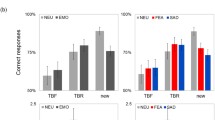Abstract
This study reports two experiments investigating the effects of transcendental meditation on right hemispheric functioning. The task used in both experiments was the Seashore Tonal Memory Test. In the first experiment a nonmeditator group and an experienced meditator group were run. The design involved three periods: a pretest, a meditation or rest period, and then a posttest. The results showed the experienced meditators were significantly better in both pretest and posttest performance. There were no pretest-posttest differences. The second experiment was done to replicate the first experiment and to control for possible selection bias. The design was the same as the first experiment, except that an additional group of inexperienced meditators was included. The results again showed significantly superior performance for the experienced meditators compared to the nonmeditators. In addition, the experienced meditators were superior to the inexperienced meditators. There were no significant differences between the nonmeditators and the inexperienced meditators. These results support the hypothesis that meditation facilitates right hemispheric functioning. Alternative explanations, such as selection bias, are also discussed.
Similar content being viewed by others
References
Bakan, P. Hypnotizability, laterality of eye movements and functional brain asymmetry.Perceptual and Motor Skills 1969,28 927–932.
Bever, T. G., & Chiarello, R. J. Cerebral dominance in musicians and non-musicians.Science 1974,184 537–539.
Bogen, J. E. The other side of the brain: II. An appositional mind.Bulletin of the Los Angeles Neurological Society 1969,34 135–162.
Chase, R. A. The effect of temporal lobe lesion on some auditory information processing tasks in man. In F. L. Darley (Ed.),Brain mechanisms underlying speech and language. New York: Grune and Stratton, 1967.
Deikman, A. Experimental meditation.Journal of Nervous and Mental Diseases 1963,136 329–373.
Doyle, J. C., Ornstein, R., & Galin, D. Lateral specialization of cognitive mode: II EEG frequency analysis.Psychophysiology 1974,11 567–578.
Ferguson, P. C., & Gowan, J. The influence of transcendental meditation on anxiety, depression, aggression, neuroticism, and self-actualization. In D. P. Kannellakos & J. Lucas (Eds.),The psychobiology of transcendental meditation: A literature review. Menlo Park: W. A. Benjamin, 1974.
Galin, D. Implications for psychiatry of left and right cerebral specialization.Archives of General Psychiatry 1974,31 572–583.
Goldstein, L., & Stoltzfus, N. Psychoactive drug-induced changes of interhemispheric EEG amplitude relationships.Agents and Action 1973,3 124–132.
Goldstein, L., Stoltzfus, N., & Gardocki, G. Changes in interhemispheric amplitude relationships in the EEG during sleep.Physiology and Behavior 1972,8 811–815.
Goleman, D. J., & Schwartz, G. E. Meditation as an intervention in stress reactivity.Journal of Consulting and Clinical Psychology 1976,44 456–466.
Gordon, H. W. Hemispheric asymmetries in the perception of musical chords.Cortex 1970,6 387–398.
Gur, R. C., & Gur, R. E. Handedness, sex and eyedness as moderating variables in the relation between hypnotic susceptibility and functional brain asymmetry.Journal of Abnormal Psychology 1974,83 635–643.
Gur, R. C., & Reyher, J. Relationship between style of hypnotic induction and direction of lateral eye movements.Journal of Abnormal Psychology 1973,82 499–505.
Gur, R. C., & Reyher, G. R. Enhancement of creativity via free-imagery and hypnosis.American Journal of Clinical Hypnosis 1976,18(4), 237–249.
Humphrey, M., & Zangwill, O. Cessation of dreaming after brain injury.Journal of Neurology, Neurosurgery and Psychiatry 1951,14 322–325.
Jernigan, T., Sadalla, E., & Ahumada, A. Relationship between “hemispherically localized” tasks. In D. O. Walter, L. Rogers, & J. M. Finzi-Fried (Eds.),Conference on human brain function. Los Angeles: Brain Information Service, 1976.
Kanellakos, D. P., & Lukas, J. S.The psychobiology of transcendental meditation: A literature review (IR & D 933535-AFB). Menlo Park, California: Stanford Research Institute, 1973.
Kimura, D. Left-right differences in the perception of melodies.Quarterly Journal of Experimental Psychology 1964,16 355–378.
Luria, A. R., Tsvetkova, L. S., & Futer, O. S. Aphasia in a composer.Journal of Neurological Sciences 1965,2 288–292.
Milner, B. Laterality effects in audition. In V. B. Mountcastle (Ed.),Interhemispheric relations and cerebral dominance. Baltimore: Johns Hopkins Press, 1962.
Nebes, R. D. Hemispheric specialization in commissurotomized man.Psychological Bulletin 1974,81 1–14.
Orme-Johnson, D. Autonomic stability and transcendental meditation.Psychosomatic Medicine 1973,35(4), 341–349.
Ornstein, R.The psychology of consciousness. San Francisco: W. H. Freeman, 1972.
Shankweiler, D. Effects of temporal-lobe damage on perception of dichotically presented melodies.Journal of Comparative and Physiological Psychology 1966,2 (1), 115–119.
Author information
Authors and Affiliations
Additional information
The authors wish to thank Ms. Michelle Ellis and Ms. Bridget Carr for their assistance in conducting these experiments. We also wish to thank the Seattle SIMS for their cooperation in obtaining subjects.
Rights and permissions
About this article
Cite this article
Pagano, R.R., Frumkin, L.R. The effect of transcendental meditation on right hemispheric functioning. Biofeedback and Self-Regulation 2, 407–415 (1977). https://doi.org/10.1007/BF00998625
Received:
Issue Date:
DOI: https://doi.org/10.1007/BF00998625




